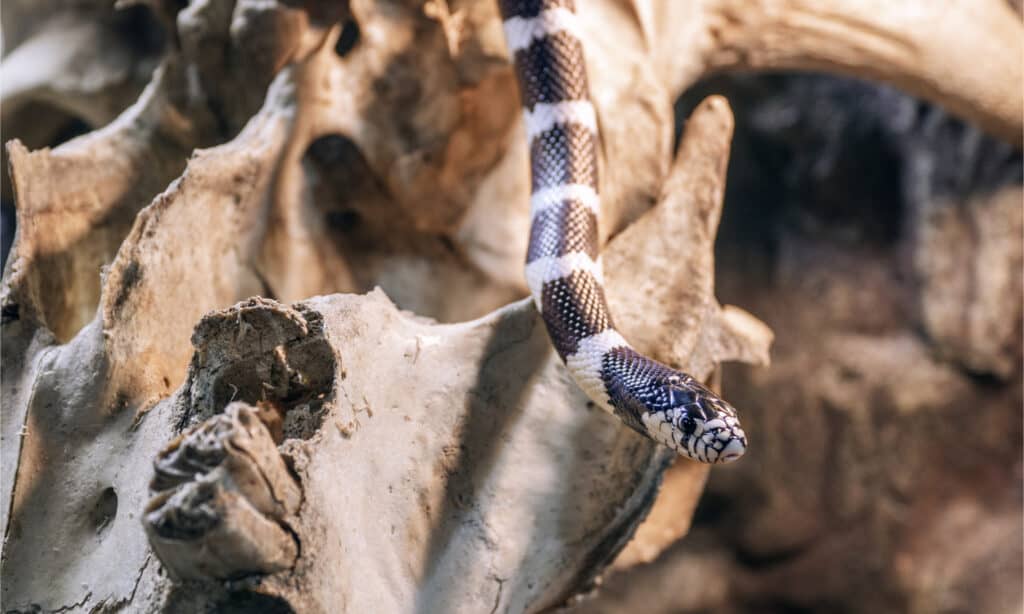California Kingsnake
.jumbotron {
background-image: url(“https://a-z-animals.com/media/2022/05/California-kingsnake-on-a-white-background-400×300.jpg”);
}
}
@media only screen and (min-width: 641px) and (max-width: 920px) {
.jumbotron {
background-image: url(“https://a-z-animals.com/media/2022/05/California-kingsnake-on-a-white-background-470×370.jpg”);
}
}
@media only screen and (min-width: 921px) {
.jumbotron {
background-image: url(“https://a-z-animals.com/media/2022/05/California-kingsnake-on-a-white-background.jpg”);
}
}
California Kingsnake
Lampropeltis californiae
A full-grown California kingsnake can be about 3.5 feet long, though there are some cases in Mexico of the snake being almost twice this size.
California Kingsnake Scientific Classification
- Kingdom
- Animalia
- Phylum
- Chordata
- Class
- Reptilia
- Order
- Squamata
- Family
- Colubridae
- Genus
- Lampropeltis
- Scientific Name
- Lampropeltis californiae
Read our Complete Guide to Classification of Animals.
California Kingsnake Conservation Status
California Kingsnake Facts
- Prey
- Lizards, amphibians, rodents, birds, and other snakes
- Name Of Young
- Snakelets or hatchlings
- Fun Fact
- A full-grown California kingsnake can be about 3.5 feet long, though there are some cases in Mexico of the snake being almost twice this size.
- Estimated Population Size
- Estimated to be between 10,000 and 100,000
- Diet
- Carnivore
- Common Name
- California kingsnake
California Kingsnake Physical Characteristics
- Skin Type
- Scales
- Venomous
- No
- Aggression
- Low
This post may contain affiliate links to our partners like Chewy, Amazon, and others. Purchasing through these helps us further the A-Z Animals mission to educate about the world’s species..

Discover alligator-eating snakes, spiders larger than your phone, and 1000 more incredible animals in our daily FREE email.
.photo-gallery {
–margin: 0px auto 0px;
–padding: 0px 0px 0px 0px;
}
.gallery-link {
background-image: url(“https://a-z-animals.com/media/2022/05/California-mountain-kingsnake-crawling-over-the-skull-of-a-cow-1024×614.jpg”);
background-repeat: no-repeat;
background-size: cover;
background-position: center;
height: 500px;
justify-content: center;
text-align: center;
align-items: center;
display: flex;
border: 2px solid #000;
}
.gallery-link img {
height: 50%;
}
@media only screen and (max-width: 768px) {
.gallery-link {
height: 300px !important;
}
}
View all of the California Kingsnake images!
5 Amazing California Kingsnake Facts
- California kingsnakes tend to be opportunistic eaters, consuming a diet of other animals in their immediate surroundings.
- Though they look like a much more dangerous species, they are not venomous or poisonous.
- A California kingsnake baby comes from an egg, and it is less than 2 feet long at birth. The baby is called a hatchling, and it takes about 65 days for the eggs to hatch.
- The average price of adopting a California kingsnake as a pet is rather low, costing using $80. Albino snakes are priced higher around $100, while a high white snake can be $200. Baby kingsnakes tend to cost more, though genetics also play a role in the price that a breeder assigns.
- A full-grown California kingsnake can be about 3.5 feet long, though there are some cases in Mexico of the snake being almost twice this size.
Where to Find California Kingsnakes
The best place to find the California kingsnake is the North American west coast where it can be found as far south as Mexico and as far north as Oregon (United States). In the United States, it can be found in Oregon, California, Nevada, Utah, Arizona, Colorado, and New Mexico. If you see one in Arizona, they are easy to mistake for a desert kingsnake or the Mexican black kingsnake. Though it is not native to any other region, there have been sightings of the California kingsnake as an invasive species in Gran Canaria, a Spanish island.
button.pulse {
transform: scale(1); animation: pulse 2s infinite;
box-shadow: 0 0 0 0 rgba(11, 247, 25, 1);
}
@keyframes pulse {
0% { transform: scale(0.90); box-shadow: 0 0 0 0 rgba(11, 247, 25, 0.5); }
60% { transform: scale(1); box-shadow: 0 0 0 15px rgba(11, 247, 25, 0); }
100% { transform: scale(0.90); box-shadow: 0 0 0 0 rgba(11, 247, 25, 0); }
}
With the ability to live in many types of habitats, you’ll see them everywhere from deserts to marshes, grasslands to woodlands, and even in suburban human communities. They are friendly from a distance, though their demeanor makes them a welcomed pet in many homes, even as a baby. Their medium size doesn’t need much tank space to be happy as long as it has a place to hide.
Scientific Name
The California kingsnake has the scientific name Lampropeltis californae. The name is Greek in origin, translating to “shiny shield” of California. The name is a reference to the snake’s smooth dorsal scales that are so glossy that they feel like the texture of enamel.
This snake is of the Reptilia class in the Colubridae family.
Population & Conservation Status
The population of California kingsnakes, sometimes referred to as California mountain kingsnakes for their proclivity for climbing, isn’t known. Researchers estimate the population to be between 10,000 and 100,000 individual snakes, but pet adoptions and local spread make it difficult to determine. The IUCN has determined that this snake is of Least Concern, so no conservation efforts are being made.
Appearance & Description
California kingsnakes are fairly medium in size at just 2.5 to 3.5 feet long, though there are some cases of being much longer. In fact, in Mexico, there are some reports of these snakes reaching 78 inches (5.5 feet) long. The color of the California kingsnake varies with many morphs, though the pattern tends to be alternating dark and light bands. The dark bands can be black or brown while the lighter bands are typically cream or white colors. While albino morphs are a little rarer, it adds to their appeal as a pet. They may also be a morph called high white, which gives them a completely white body that is speckled with black. Depending on the location, some morphs are striped along the length of their body instead of bands, often featuring a black body that is striped with yellow.
How to identify a California kingsnake:
- 2.5 to 3.5 feet in overall size when full-grown, though may grow to be longer
- Baby California kingsnakes may just be 8-12 inches
- Alternating dark and light bands or stripes of color
- Typically features brown, white, black, cream, or similar colors on bands
- Sometimes albino or “high white” morphs

Ann May Snz/Shutterstock.com
How Dangerous Are They?
Even though the California kingsnake bears a striking similarity to a much more dangerous snake, it is quite harmless. Getting bitten by a California kingsnake can be painful, but the bite won’t actually put the body at risk. If you are bitten by a California kingsnake, you’ll need to see a doctor to make sure the bite doesn’t get infected if it manages to break the skin.
California Kingsnake Behavior and Humans
With activity during the day or night, the California kingsnake is rather friendly, making it a great companion as a pet. They need to have consistent care with ambient temperatures to keep them happy, and they’ll even warn you that they don’t want to be disturbed by shaking their tail. They may also release fecal matter and an odor if shaking their tail is not enough to get you to leave them alone.
With many different morphs, they are often bred for specific colorations. Though they can’t be sold if they are wild, albino and high white California kingsnakes are some of the most exclusive and expensive morphs to keep as pets.
View all 157 animals that start with C
California Kingsnake FAQs (Frequently Asked Questions)
Are California kingsnakes friendly?
The California kingsnake is quite a popular pet, and they have a quite friendly demeanor. They are easy to care for, though they are not the best match for everyone.
Do California kingsnakes bite?
Without any venom, the California kingsnake isn’t very dangerous, but being surprised, scared, or threatened may lead it to do so. Luckily, without this venom, the bite won’t do more than hurt a little.
Are California kingsnakes harmless?
Not exactly. While it is true that they have no venom, they can still constrict around prey to kill it.
Why are California kingsnakes good pets?
While they look like their more dangerous counterparts, they are incredibly harmless and quite friendly when they become used to their handler. For wild California kingsnakes, a full-grown adult costs about $80 or less, though there are many factors that play a role in the price (like age and genetics). With the right care, their average lifespan is 20 years or more.
Where do California kingsnakes live?
The California Kingsnake lives in the state that it is named for, but it also lives in Oregon, Arizona, Utah, and Nevada in the United States. They also live in Mexico, and they are accustomed to many different habitats, like marshes, woodlands, grasslands, and deserts. Whether in the wild or in captivity, their average lifespan is 20 years or more.
Are California kingsnakes venomous?
No. The California kingsnake has no venom, and it only bites if it feels threatened. They are not poisonous.
How do California kingsnakes hunt?
The California kingsnake is a constrictor, wrapping its body around its prey to kill it before eating it. Their jaw is able to open way larger than their body to help them swallow food bigger than themselves. It only swallows its prey headfirst.
Are California kingsnakes aggressive?
Not usually. The only way that they might become aggressive is if you startle one or touch it when it is trying to hide. Luckily, since they are not poisonous, one bite poses very little threat.
What do California kingsnakes eat?
The typical diet of the California kingsnake is made of rodents, birds, reptiles, and amphibians. However, they primarily eat based on the opportunity they have of the animals around them. They actually get the “king” in their name from one part of their diet – other snakes. They even are resistant to rattlesnake venom.
Sources
- Reptile Rapture, Available here: tps://reptilerapture.net/california-kingsnake-caresheet.html
- Animalia Bio, Available here: https://animalia.bio/california-kingsnake
- Wikipedia, Available here: https://en.wikipedia.org/wiki/California_kingsnake
- Reptile How, Available here: https://reptilehow.com/how-much-does-a-kingsnake-cost/
















